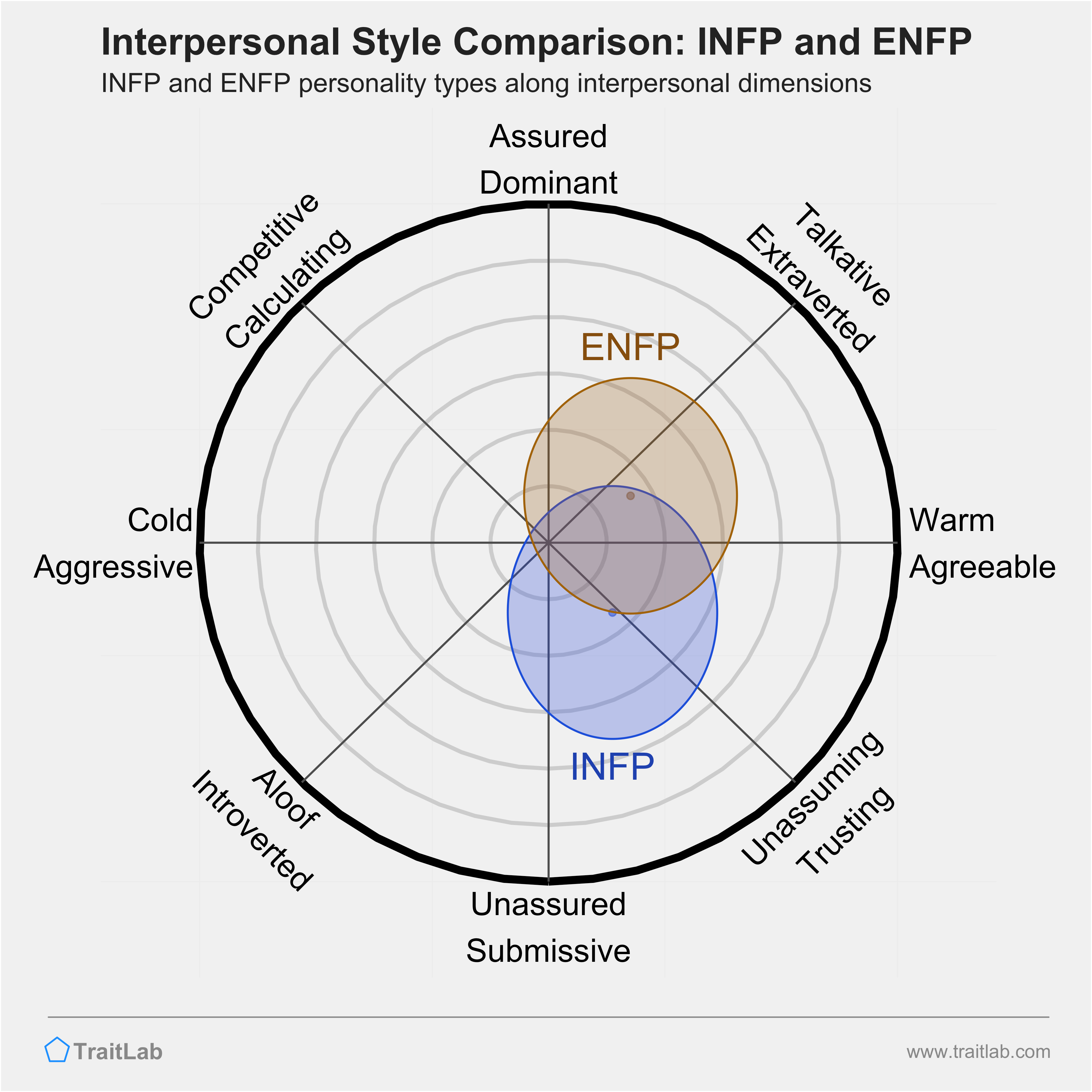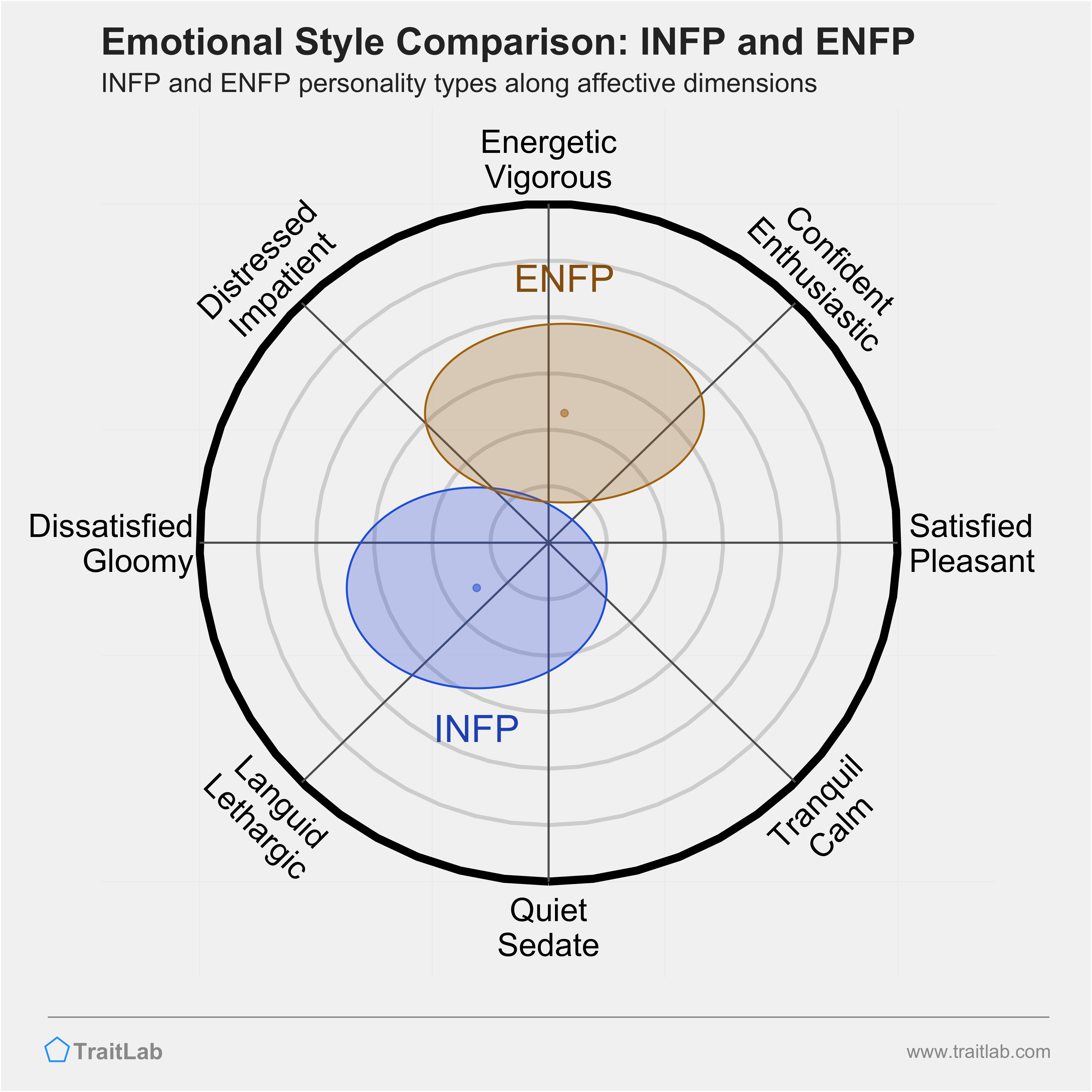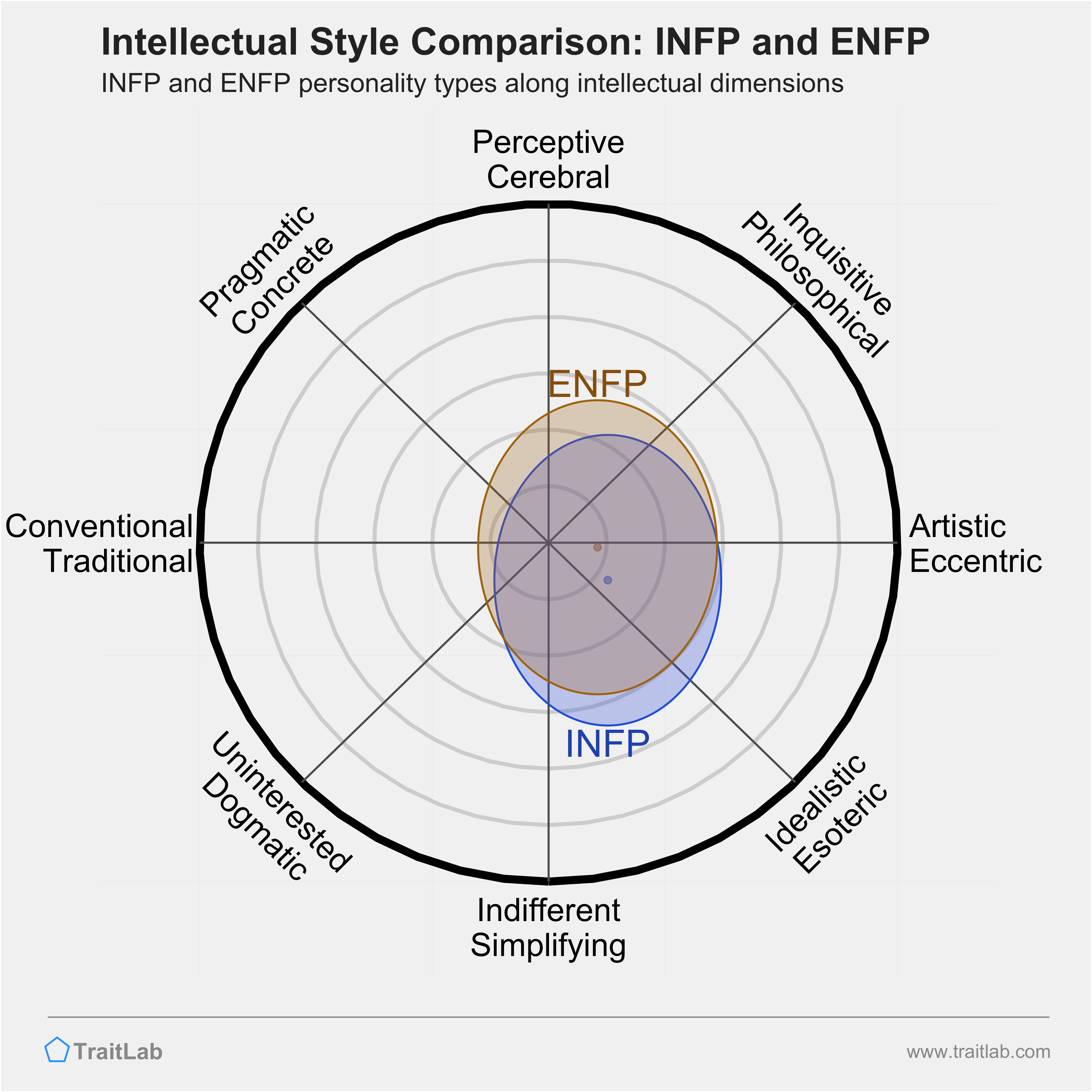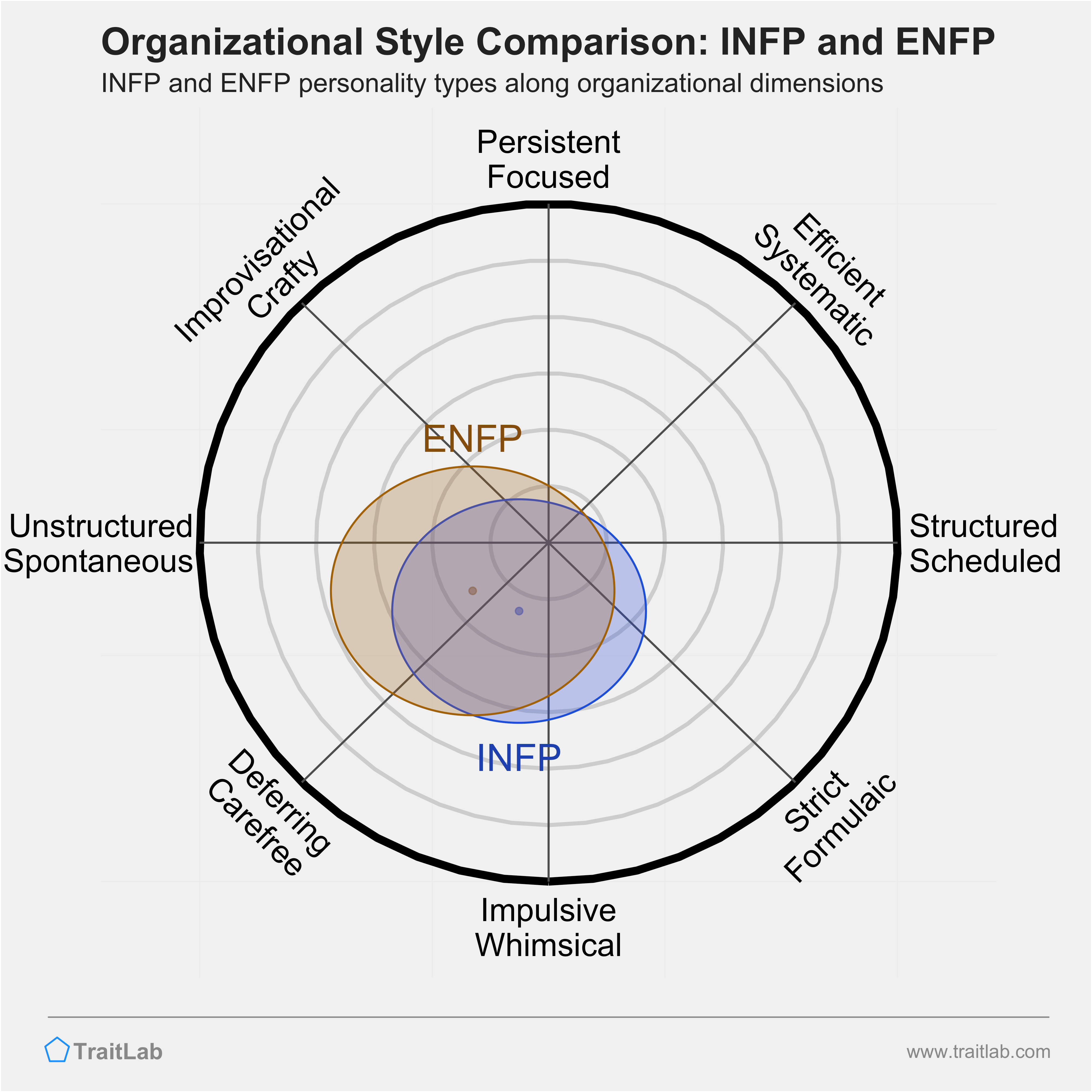How compatible are INFP and ENFP patterns of communicating, thinking, and working?
Reading time: 5 minutes

Gregory Park, Ph.D.
Author
In this article, you’ll find a comparison of INFPs and ENFPs across five important personality domains: Interpersonal/Communication Style, Emotional Style, Intellectual Style, and Organizational Style.
One important note: the following comparisons cannot be made simply by comparing the cognitive functions (letters) of each personality type.
For this analysis, TraitLab gathered data about personality traits from thousands of participants who identified themselves as a particular type in the 16 Personality or Myers-Briggs framework.
The comparisons here show the average similarities and differences between INFPs and ENFPs. However, remember that all personality types are oversimplifications. For an assessment of your unique position in these areas, you’ll need a personalized assessment that doesn’t rely on personality types.
Jump to any section with the links below.

Do you know your personality type?
Learn about your type and so much more with TraitLab's comprehensive personality assessment.
Your particular style of communicating and interacting with others can be described fairly well by two dimensions: assertiveness and warmth.
Assertiveness describes your tendency to assert yourself, lead, and influence others in social situations, while warmth describes your tendencies to empathize and put others’ needs ahead of your own.
People with the same personality type often share some similarities in assertiveness and warmth. In the graph below, you can see where most INFPs and most ENFPs fall along both of these dimensions.
First, take a look at where people in each type, on average, fall in this interpersonal space.

INFPs often respect others, conform to expectations, and ask for guidance. At their best, they are loyal and reliable, and encourage others to guide and help. INFPs may be overly clingy, gullible, and have difficulty expressing anger, even when appropriate. At their worst, they will try to please others too much, put others’ needs ahead of their own, and allow others to take advantage of them.
ENFPs often support, openly sympathize, and actively offer help to others At their best, they are gentle sympathizers, who are easily trusted and accepted. ENFPs may be overly revealing and have difficulty being alone. At their worst, they can require too much attention and admiration from others and be excessively involved in the affairs of others.
One aspect that you and many ENFPs have in common in their interpersonal warmth. Both INFPs and ENFPs tend to be on the friendlier side and are attentive to the needs and interests of other people, sometimes at the expense of your own goals.
One important difference between you and most ENFPs is in your relative assertiveness or passivity in social situations. Like many INFPs, you are often on the more passive, reserved side of the spectrum. In some cases, this is a perfect compliment to ENFPs’ more dominant, assertive style, and the two of you can make an effective team. However, you may find that you need to put extra effort into making your opinions heard when working with ENFPs.
Another characteristic of your personality is your emotional style — your tendencies towards different kinds of moods. There are two dimensions that influence emotional style: arousal and valence.
Arousal describes your relative energy level across different situations. Those with high baseline levels of arousal tend to be generally more alert, active, and engaged, while those with a lower baseline are more reserved, subdued, and inhibited.
Valence describes whether these moods tend to be positive (pleasant) or negative (unpleasant). People with a more positively valenced style are more likely to experience emotions like joy, enthusiasm, satisfaction, and serenity. People with a more negatively valenced style are more likely to experience sadness, frustration, dissatisfaction, and anxiety.
The graph below shows where each type, on average, usually sits in this emotional space.

INFPs have a tendency to be quiet and inhibited. Compared to most people, they can easily drift into gloom and melancholy. They see the glass as half-empty and have a more skeptical outlook and a hesitant approach to life. For better or worse, INFPs tend to notice the negatives in most situations. In stressful times, they are more likely to withdraw quietly and retreat inward, rather than share their frustration with others.
ENFPs tend to be energetic and enthusiastic across most situations. They take on new challenges with excitement, confidence, and a sense of adventure. ENFPs are usually more optimistic than most people, and they generally feel like they can handle what life throws at them.
As with most INFPs, you tend to be more reserved, inhibited, and quiet than most ENFPs. Between the two of you, you are more likely to need more personal space, solitude, and time to decompress. While you can tolerate long periods of calm and quiet, your ENFP counterparts often craves more engagement and excitement. In the best cases, an ENFP can pull you out of your comfort zone and get you out into the world, while your quiet nature helps to balance out their intensity.
Another difference between INFPs and ENFPs in their typical emotional valence, or their tendencies towards positive and negative emotions. You and most INFPs tend to fall on the more negative side. Compared to most ENFPs, you and most INFPs typically experience more negative emotions like sadness, worry, frustration, and impatience. ENFPs have the opposite pattern, and they tend to gravitate toward positive emotions like enthusiasm, joy, and contentment.
These emotional differences can be subtle, but they may color how INFPs and ENFPs process new information. You and most INFPs are quicker to see the negatives and consider what could go wrong, while ENFPs might receive the same news with excitement and optimism.
Your intellectual style describes how you receive, process, and pursue different kinds of information. Differences in intellectual style are captured well by two dimensions: ideas and aesthetics.
Ideas describes your appetite for new information and your interest in complex, challenging material. People high on the ideas dimension have an appreciation for complexity and technical details. People lower on ideas are less interested in learning for learning’s sake, and they prefer to simplify complex topics down to the essential details.
Aesthetics captures your relative interest and sensitivity to aesthetic information and its emotional impact. People higher on the aesthetics dimension usually have strong artistic interests and a deep appreciation for beauty in many forms. Those lower on aesthetics tend to value practical application over artistic merit and usually adhere to more conventional standards of beauty.
In the graph below, you’ll see where INFPs and ENFPs, on average, fall in this intellectual space.

Most INFPs and ENFPs overlap heavily in their intellectual style.
INFPs and ENFPs are idealistic, creative dreamers. They tend to be interested in the nuances of emotional and artistic experiences, looking for patterns and meaningful insights. INFPs and ENFPs are comfortable with ambiguity and abstract concepts, focusing on the big picture rather than technical details. They often practice some form of creative expression and are likely to hold a few unconventional, eccentric beliefs.
As an INFP, you and most ENFPs are down-to-earth, straightforward thinkers. You’d both prefer to stick to the essentials and focus on practical issues, and you try to avoid overcomplicating matters. When you and your ENFP counterpart are together, your conversations are more likely to revolve around concrete details, facts, and conventional topics rather than theoretical or philosophical ones.
Likewise, both INFPs and ENFPs share a deep appreciation for beauty in the natural and artistic world. Both of you can easily become absorbed in aesthetic experiences and overcome with a sense of awe and wonder. The two of you can find common ground in your love of creative expression and unconventional approaches to life’s challenges.
Your organizational style describes your habits around organization and planning. Your organizational style influences how you structure your time and physical space. Differences in organizational style fall along two dimensions: industriousness and orderliness.
Industriousness describes your persistence, need for achievement, and intensity of focus. People higher on industriousness usually organize their behavior around a few important long-term goals. People lower on industriousness are usually more focused on the present and will more easily change their focus when new opportunities appear.
Orderliness describes your need for regularity, order, and structure in your environment. People higher on orderliness prefer tidy, organized physical spaces, detailed schedules, and reliable routines. People lower on orderliness can tolerate more disorganization and prefer a more spontaneous, unstructured approach.
The graph below shows the average position of INFPs and ENFPs along these dimensions of organizational style.

Most INFPs and ENFPs share a similar organizational style.
INFPs and ENFPs thrive in unstructured environments with fewer constraints and more room for improvisation and serendipity. They generally focus on enjoying the present rather than preparing for the future. INFPs and ENFPs highly value spontaneity and the flexibility to change their mind, and they resist setting hard deadlines or rigid expectations.
Like most INFPs, you and many ENFPs often set ambitious goals but struggle to stick to those plans in the long run. As new opportunities arise, you easily change direction, losing interest or motivation to pursue your past goals. As a result, the two of you often postpone important or difficult decisions, which sometimes creates tension between you due to lost opportunities or last-minute rushing. Both of you tend to perform better under external pressure rather than being left to your devices. You can benefit greatly by holding each other accountable and providing gentle motivation when needed.
Similarly, INFPs and ENFPs share a more intuitive, unstructured approach to most areas of their lives. Both of you take life as it comes, and you avoid overly detailed plans and high levels of organization. Compared to most people, the two of you also have higher tolerances for messiness and disorganization.
Most people have complex personalities and don’t fall into a single personality type.
With TraitLab’s comprehensive analyses of your traits, strengths, and interests, you can see how your personality compares to all 16 types. Start building your personality profile by creating a free account today.
For comparisons between INFPs and other types from the 16 Personality typology, visit any of the type pairings below:
For comparisons between INFPs and other Enneagram types, visit any of the type pairings below: